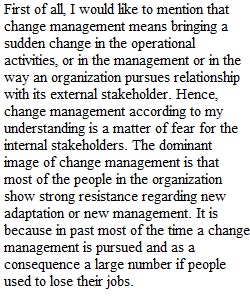


Q After reading Chapter 2 covering the six images of change management, please answer the following questions: 1. Is it likely that most people will have one dominant image of change management? 2. Are change leaders who have the capacity to apply a range of different images more likely to be successful? 3. In your judgment, do most managers have the behavioral flexibility to move between different styles, or do they tend to apply just one or a limited range of approaches? Can you think of example in which someone wasn’t able to successful demonstrate the behavioral flexibility that a situation required? Please read the turn around story at Leonard Chesire on pg. 53 of Managing Organizational Change: 1. What image, or images, of change management does Clare Pelham illustrate? Please explain. Go back to the JC Penney example from Chapter 1: 1. If you had become CEO in 2011 (instead of Ron Johnson) which of the six images of change management would you have demonstrated in the role? Please explain. Which image of change did Ron Johnson’s actions portray?
View Related Questions